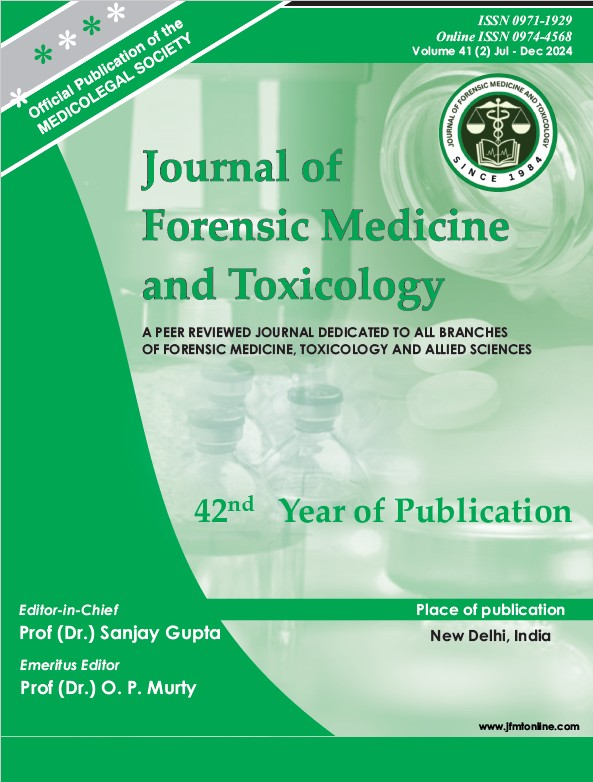Absolute to Obsolete: A Toxic Journey
DOI:
https://doi.org/10.48165/jfmt.2025.42.2.19Keywords:
Toxicology, Absolute, ObsoleteAbstract
As scientific knowledge expands and technology advances, certain traditional practices in toxicology have become obso lete in the current era. This article delves into some of these outdated approaches, highlighting the need for their replace ment with more modern and sophisticated methods. The article highlights the importance of toxicology as a discipline, the current scenario and practice and why we need to bring change in study material taught to undergraduate and post graduate students. The topics which are still taught and are of no relevance in the present time need to be removed and the common treatment and testing methods which could be useful in clinical practice should be given importance. By shedding outdated practices, toxicology in the current era aims to provide more accurate, reliable, and applicable insights into the potential risks posed by various chemicals on human health and the environment.
Downloads
References
Chung, H., & Choe, S. (2017). Overview of forensic toxicology, yesterday, today and in the future. Current Pharmaceutical Design, 23(36), 5429–5436. https://doi.org/10.2174/1381612823666170622101633. PMID: 28641536.
Cosbey, S., Elliott, S., & Paterson, S. (2017). The United Kingdom and Ireland Association of Forensic Toxicologists; establishing best practice for professional training & development in forensic toxicology. Science & Justice, 57(1), 63–71. https://doi.org/10.1016/j.scijus.2016.10.003. PMID: 28063588.
Kotur, P. F. (2012). Introduction of evidence-based medicine in undergraduate medical curriculum for development of professional competencies in medical students. Current Opinion in Anaesthesiology, 25(6), 719–723. https://doi.org/10.1097/ACO.0b013e32835a1112. PMID: 23103843.
Zhou, N., Wu, Y., Su, T., Zhang, L., Yin, K., Zheng, D., Zheng, J., Huang, L., Wu, Q., & Cheng, J. (2017). Course constructions: A case base of forensic toxicology. Journal of Forensic and Legal Medicine, 50, 36–38. https://doi.org/10.1016/j.jflm.2017.06.006. PMID: 28689029.
Wille, S. M. R., Coucke, W., De Baere, T., & Peters, F. T. (2017). Update of standard practices for new method validation in forensic toxicology. Current Pharmaceutical Design, 23(36), 5442–5454. https://doi.org/10.2174/1381612823666170714154444. PMID: 28714407.
Peters, F. T. (2007). Stability of analytes in biosamples – an important issue in clinical and forensic toxicology? Analytical and Bioanalytical Chemistry, 388(7), 1505–1519. https://doi.org/10.1007/s00216-007-1267-2. PMID: 17429615.
Smith, M. L., Vorce, S. P., Holler, J. M., Shimomura, E., Magluilo, J., Jacobs, A. J., & Huestis, M. A. (2007). Modern instrumental methods in forensic toxicology. Journal of Analytical Toxicology, 31(5), 237–253, 8A–9A. https://doi.org/10.1093/jat/31.5.237. PMID: 17579968; PMCID: PMC2745311.
Augsburger, M., & Staub, C. (2008). La toxicologie forensique, une discipline scientifique en plein essor [Forensic toxicology, a growing scientific discipline]. Revue Médicale Suisse, 4(164), 1605–1608. PMID: 18711973.
Drummer, O. H. (2010). Forensic toxicology. EXS, 100, 579–603. https://doi.org/10.1007/978-3-7643-8338-1_18. PMID: 20358697.
Wyman, J. F. (2012). Principles and procedures in forensic toxicology. Clinics in Laboratory Medicine, 32(3), 493–507. https://doi.org/10.1016/j.cll.2012.06.005. PMID: 22939304.
Drummer, O. H. (2017). Good practices in forensic toxicology. Current Pharmaceutical Design, 23(36), 5437–5441. https://doi.org/10.2174/1381612823666170704123836. PMID: 28677500.
Barcelo, B., Noce, V., & Gomila, I. (2018). Building bridges between clinical and forensic toxicology laboratories.Current Pharmaceutical Biotechnology, 19(2), 99–112. https://doi.org/10.2174/1389201019666180509163603. PMID: 29745329.
Eaton, D., & Greenlee, W. (2002). Fundamentals are still relevant in toxicology. Nature, 417, 117. https://doi.org/10.1038/417117b.
Picchioni, A. L., Chin, L., Verhulst, H. L., & Dieterle, B. (1966). Activated charcoal vs “universal antidote” as an antidote for poisons. Toxicology and Applied Pharmacology, 8(3), 447–454. https://doi.org/10.1016/0041-008X(66)90054-8.




